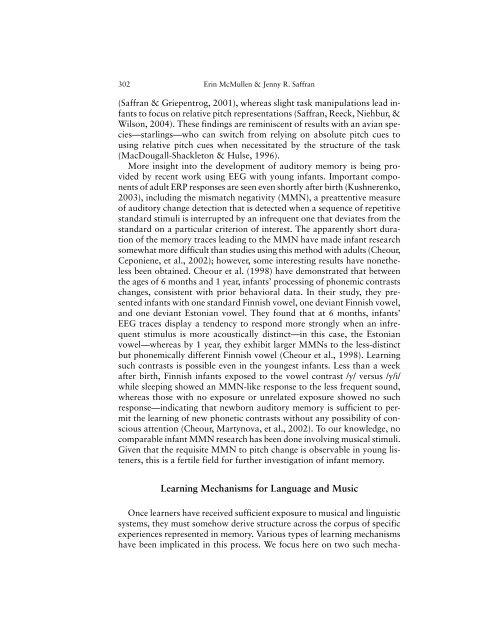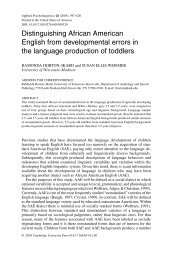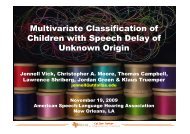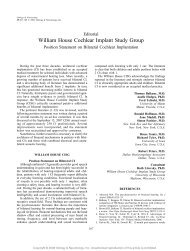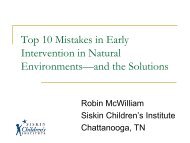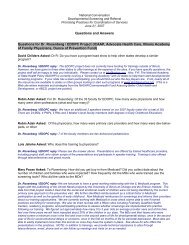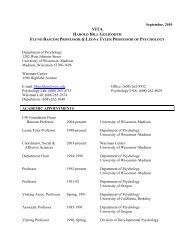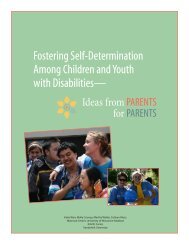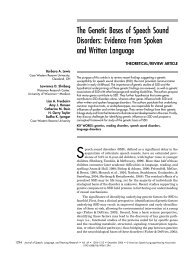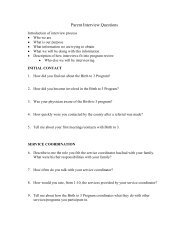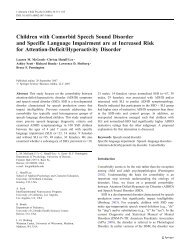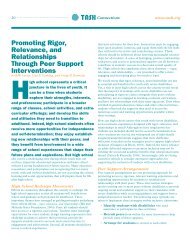Music and Language: A Developmental Comparison - Waisman ...
Music and Language: A Developmental Comparison - Waisman ...
Music and Language: A Developmental Comparison - Waisman ...
Create successful ePaper yourself
Turn your PDF publications into a flip-book with our unique Google optimized e-Paper software.
302 Erin McMullen & Jenny R. Saffran(Saffran & Griepentrog, 2001), whereas slight task manipulations lead infantsto focus on relative pitch representations (Saffran, Reeck, Niehbur, &Wilson, 2004). These findings are reminiscent of results with an avian species—starlings—whocan switch from relying on absolute pitch cues tousing relative pitch cues when necessitated by the structure of the task(MacDougall-Shackleton & Hulse, 1996).More insight into the development of auditory memory is being providedby recent work using EEG with young infants. Important componentsof adult ERP responses are seen even shortly after birth (Kushnerenko,2003), including the mismatch negativity (MMN), a preattentive measureof auditory change detection that is detected when a sequence of repetitivest<strong>and</strong>ard stimuli is interrupted by an infrequent one that deviates from thest<strong>and</strong>ard on a particular criterion of interest. The apparently short durationof the memory traces leading to the MMN have made infant researchsomewhat more difficult than studies using this method with adults (Cheour,Ceponiene, et al., 2002); however, some interesting results have nonethelessbeen obtained. Cheour et al. (1998) have demonstrated that betweenthe ages of 6 months <strong>and</strong> 1 year, infants’ processing of phonemic contrastschanges, consistent with prior behavioral data. In their study, they presentedinfants with one st<strong>and</strong>ard Finnish vowel, one deviant Finnish vowel,<strong>and</strong> one deviant Estonian vowel. They found that at 6 months, infants’EEG traces display a tendency to respond more strongly when an infrequentstimulus is more acoustically distinct—in this case, the Estonianvowel—whereas by 1 year, they exhibit larger MMNs to the less-distinctbut phonemically different Finnish vowel (Cheour et al., 1998). Learningsuch contrasts is possible even in the youngest infants. Less than a weekafter birth, Finnish infants exposed to the vowel contrast /y/ versus /y/i/while sleeping showed an MMN-like response to the less frequent sound,whereas those with no exposure or unrelated exposure showed no suchresponse—indicating that newborn auditory memory is sufficient to permitthe learning of new phonetic contrasts without any possibility of consciousattention (Cheour, Martynova, et al., 2002). To our knowledge, nocomparable infant MMN research has been done involving musical stimuli.Given that the requisite MMN to pitch change is observable in young listeners,this is a fertile field for further investigation of infant memory.Learning Mechanisms for <strong>Language</strong> <strong>and</strong> <strong>Music</strong>Once learners have received sufficient exposure to musical <strong>and</strong> linguisticsystems, they must somehow derive structure across the corpus of specificexperiences represented in memory. Various types of learning mechanismshave been implicated in this process. We focus here on two such mecha-


